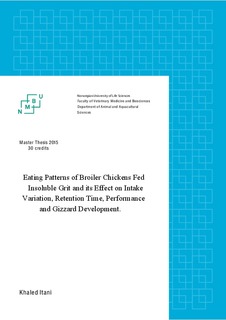| dc.description.abstract | In a field trial, the current study tested the effects of insoluble granite grit stones supplemented to broiler chickens on growth performance and gizzard stimulation. Particle size distribution and variation in the amount of grit retained in the gizzards were also examined at different age intervals. 880-day-old broiler chicks were allocated randomly and equally to 11 floor pens and maintained on a commercial pelleted diet. The trial consisted of two treatments: a control, or no-grit group (NGG), and a grit treatment group (GG). During the first three days, all pens were managed under the same conditions. On day four, chicks in the GG were given grit stones (sieved to a size range of 3.55 to 1.6mm) on separate plates. Grit provision was initiated with 150 grams per pen, and continued on days seven, nine and eleven respectively with 350g per pen, making 1200g in total or 15g per bird. On day 18, uneaten grit was withdrawn from all pens. At 10, 21 and 28 days, randomly selected grit-fed birds were killed and frozen for laboratory analysis. At 30 days of age, 208 gizzards from both groups (416 in total) were collected
from the slaughter house. 72 gizzards from the 208 were randomly selected to examine the variation in the amount of grit retained at the end of the trial. Finally, grit from the rest of the gizzards was pooled in one sample and analyzed for particle distribution. The findings showed grit supplementation did not impair nor improve (P > 0.05) broiler overall performance compared to the NGG. Grit significantly increased (P < 0.001) gizzards' size, and their full and empty weight in the grit-fed birds. Birds from the GG showed individuality in the amount of grit ingested at different ages and the variation in the amount retained increased with age. Grit seemed to be evenly distributed among gizzard contents, which provided more contact surface with the feed and efficient particles grinding. On average, grit accounted for almost 36% of the total gizzard content weight at 10 and 21 days, but dropped to 21% at 28 days of age. Retained grit varied from zero to 368 particles. Of the 208 gizzards, 8% retained nil, and 3% contained very few, whereas the remainder retained a considerable amount even 12 days after withdrawal. The average number of stones found in the gizzards was 161, 231 and 140 stones, while the maximum amounts were 243, 366 and 368 stones at 10, 21 and 28 days respectively. It was observed in the small intestine that some grit of different sizes were passing through the gizzard almost completely intact during various growth periods. Gizzard grit appeared to have smoother surfaces with rounded corners due to erosion as opposed to the rough, irregular and sharp edges of the initial grit. Particle size distribution showed a conspicuous reduction in larger particle proportion and a subsequent increase in the medium and small particles fraction. | nb_NO |
